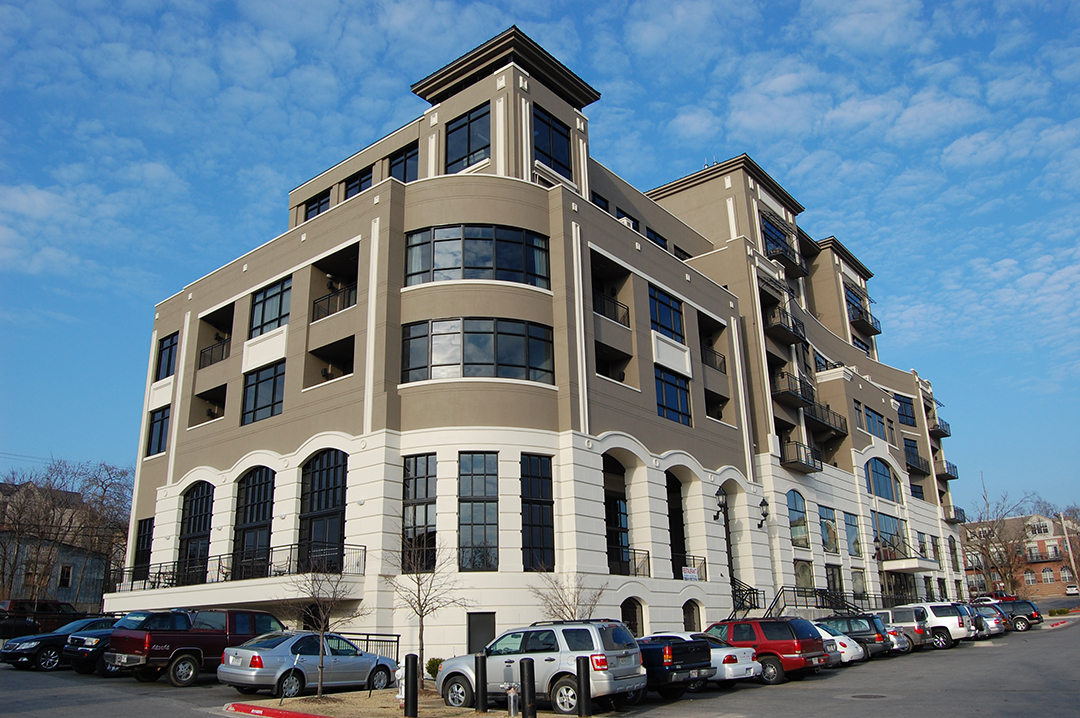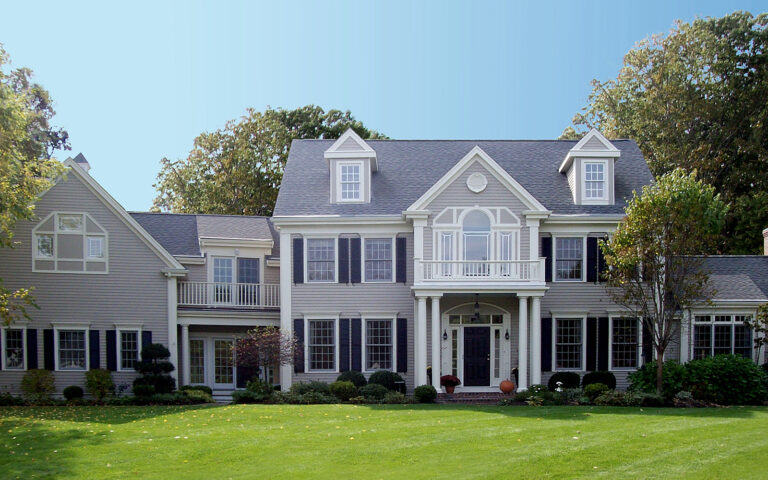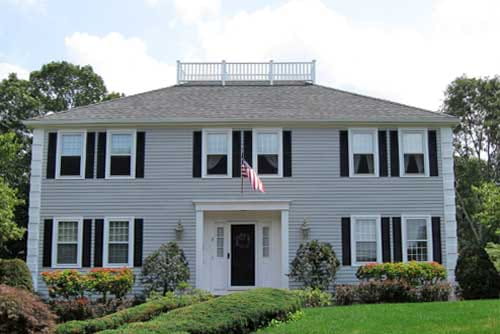Exterior Painting Cost: 2024 Guide
 As a homeowner in New England, you’re no stranger to the challenges posed by the region’s weather. From scorching summers to bitter winters and everything in between, your home’s exterior faces a constant battle against the elements. So, when it comes to maintaining its appearance and protecting its structure, understanding the costs of exterior painting is crucial.
As a homeowner in New England, you’re no stranger to the challenges posed by the region’s weather. From scorching summers to bitter winters and everything in between, your home’s exterior faces a constant battle against the elements. So, when it comes to maintaining its appearance and protecting its structure, understanding the costs of exterior painting is crucial.
At Rhino Shield, we’re often asked, “What’s the average cost to paint a home in New England?” It’s a valid question, and one that requires a nuanced answer. Our homes are one of the biggest investments we will ever make, so we here at Rhino Shield want to be as transparent as possible about exactly what you can expect when it comes to the cost of exterior painting. Our hope is that after this article, you can make an informed decision on what’s best for you and your home. Let’s delve into the factors that influence pricing and break down the costs step by step.
Understanding the Average Cost
In New England, the average cost of an exterior paint job typically ranges from 4-7$ per square foot. This figure encompasses a full-service package, including materials, labor, preparation, and other associated expenses. However, it’s important to note that this is just a baseline estimate, and several variables can cause prices to fluctuate.
How The Age and Style of Your Home Impact Pricing
One of the prevalent aspects of pricing an exterior paint job in New England specifically is the age and style of the home. The age and style of your home can significantly influence the cost of painting its exterior. Homes with elaborate architectural designs often demand a higher level of precision and attention to detail, driving up labor costs. Additionally, it is commonplace for homes in New England to be from the 18th or 19th century, which can come with layers of old paint.
If your home was constructed prior to 1978, the walls may contain lead paint, which requires specialized removal procedures mandated by the EPA. These procedures add to the overall cost of the project but are essential for ensuring the safety of both the occupants and the workers. Knowing the age of your home is vitally important not only for understanding pricing of exterior painting, but for your overall health as well.
Characteristics of Your Home that Influence Pricing
Beyond just the age and architectural style of your home, several other features can impact the cost of painting its exterior. Let’s delve into these features to gain a comprehensive understanding of how various aspects of your home influence pricing. Here are some important considerations to keep in mind:
- Preparation and Inspection: Before a single brushstroke is made, your home must undergo a thorough examination and preparation process. This includes addressing issues such as cracks, bio-growth accumulation, substrate issues, and rotted wood. These repairs can be addressed by the crew as most crews have experience in carpentry. Making sure your home is fully prepared to be painted is vital to achieve a lasting coating, especially in New England’s climate.
- Type of Siding: The type of siding your home has can also affect the cost of painting. These can vary from rough clapboard, shingles, cement board, aluminum, and smooth clapboard. Natural wood, for example, may require additional preparation and maintenance, which can add additional costs to the project.
- Architectural Style: As we discussed, homes with elaborate architectural designs often demand a higher level of precision and attention to detail, especially prevalent in New England’s historic neighborhoods. Intricate trim, gutters, and millwork can increase labor costs and necessitate specialized paint types, contributing to higher overall prices while preserving the region’s unique architectural heritage.
- Number of Stories: The height and complexity of your home’s design can also influence pricing, particularly relevant in New England’s densely populated urban areas with narrow lots and multi-story dwellings. Multi-story homes may require additional equipment, such as ladders or boom lifts, to access hard-to-reach areas, resulting in increased labor costs, a common consideration in this region’s neighborhoods.
- Location: Your home’s location can impact pricing as well. Properties located in densely populated urban areas may face logistical challenges that raise overall costs, such as limited access for equipment or parking restrictions for contractors. Additionally, in New England’s coastal areas, homes are subjected to salt air, requiring specialized coatings for enhanced durability, which can affect pricing.
- Condition of Current Paint: If your home has existing paint that requires removal or extensive preparation before applying a new coat, this can add to the labor costs of the project. In New England, where homes endure extreme temperature fluctuations and moisture exposure, addressing issues with the current paint is crucial for ensuring the longevity of the new coating.
Factors Influencing Labor Costs
Now that we have covered what aspects of your home can affect pricing, let’s discuss how the process of actually painting your home affects pricing. When it comes to determining how material and labor costs will affect the overall price of the project, there are numerous variables that we must consider:
-
- Quality of Materials: The quality of the paint and materials used can vary widely, with higher-quality products typically commanding a higher price. While premium paints may cost more upfront, they often provide greater durability and longevity, a solid benefit for harsher climates. The prices of these materials will also be influenced by where you live. Specialized equipment such as lifts and scaffolding will depend on the local market value and will contribute to the total cost of the project.
- Multiple Colors: Using multiple colors for your exterior paint job can increase labor and material costs, as each additional color requires additional masking and application time. In New England, where historical preservation is often a priority, homeowners may opt for intricate color schemes to complement the region’s diverse architectural styles, adding to the complexity and cost of the project.
- Priming: If you’re changing the color of your home or dealing with certain types of surfaces, such as bare wood or metal, priming may be necessary to ensure proper adhesion and coverage. This additional step can add to the overall cost of the project. Moreover, in New England, where homes are frequently exposed to moisture and temperature fluctuations, proper priming is essential for preventing premature paint failure and preserving the structural integrity of the exterior surfaces.
- Trim Work: Painting trim and other details requires precision and attention to detail, which can increase labor costs compared to painting larger, flat surfaces. In New England, where we have mentioned that many homes feature elaborate architectural details such as crown molding, intricate trim work, and decorative accents, meticulous attention to detail is paramount. Specialized techniques and additional labor may be required to ensure a pristine finish, contributing to higher overall costs but preserving the region’s architectural charm.
- Overall Labor Costs: In New England, labor costs for painting the exterior of a home are typically calculated by square feet and levels of preparation. Since the region is characterized by diverse architectural styles and often historic properties, the time required for preparation, painting, and detailing can vary significantly from one project to another. The longer it takes to complete the job, the more expensive the overall project is likely to be.
Warranty and Guarantees
Some contractors may offer warranties or guarantees on their work, which can provide added peace of mind but may also be reflected in higher prices. The price of the warranty can be influenced by the amount of years it’s being offered, potential labor costs, and the quality of the paint being used. Depending on your typical climate implications and how long you expect the paint to last, a warranty may be beneficial for you. However, always be aware of the additional costs that can come with choosing to add a warranty to your project.
Securing a paint job for your home’s exterior often involves questions about down payments and financing options. Let’s address these concerns.
Do I Need a Down Payment to Get a Paint Job?
When scheduling a paint job, it’s common for contractors to request a deposit upfront. This deposit typically ranges from 10% to 50% of the total cost. Higher-end deposits may be required to cover material costs, especially for larger projects or those with imminent start dates. However, the exact amount and timing of the down payment can be negotiated with your contractor. For projects scheduled in the distant future, lower down payment percentages may be accepted. Remember, you have the flexibility to discuss payment terms with your contractor to find a solution that works for both parties.
Can I Finance My Painting Project?
Financing options are often available for painting projects, offering flexibility in payment arrangements. Many painting companies offer financing opportunities to help homeowners manage the cost of their projects. It’s essential to inquire with your local contractor about any potential financing options they may offer. Additionally, larger jobs may qualify for customer discounts and seasonal sales are prevalent in the industry. Be sure to explore all available financing and discount options to find the best solution for your needs and budget.
Conclusion: Making an Informed Decision
When it comes to painting your home’s exterior in New England, there’s no one-size-fits-all answer to the question of cost. Instead, it’s essential to consider the unique factors that apply to your property and seek out reputable contractors who can provide accurate estimates based on your specific needs.
Whether you’re looking to refresh your home’s appearance or protect it from the elements for years to come, understanding the costs involved is the first step toward making an informed decision. By taking the time to research your options and solicit multiple quotes, you can ensure that you’re investing in a solution that meets your needs and fits your budget.
If you would like to learn about how Rhino Shield can protect your home and receive a free, no-obligation quote, call us today at 888-907-4466, or schedule a price quote here. Thank you for your consideration.





0 Comments